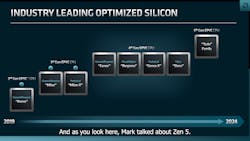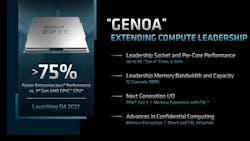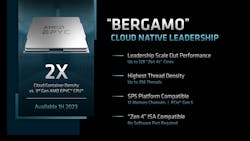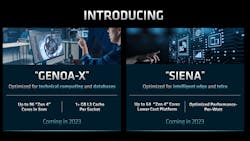EPYC CPUs Target Edge and Data-Center Tasks
Check out more Technology Talks videos.
AMD's latest servers include a suite of four families that target the cloud as well as edge server computing. AMD's Dan McNamara presents this new platform in the video that's summarized here.
The new families are code-named Genoa, Bergamo, Genoa-X, and Siena (Fig. 1). The latter targets edge computing with a lower core count, but it has lower power requirements as well. They're all based on AMD's latest 5-nm, Zen 4 core that's also used on mobile and desktop processors. One of the main differences is the server chips have more bandwidth and cores along with acceleration that suits server applications.
Genoa pushes bandwidth and cloud flexibility with Compute Express Link (CXL) support for memory (Fig. 2). CXL allows for aggregation of memory and storage so that it can be allocated across the cloud. It's based on PCI Express (PCIe) and the chips support PCIe Gen 5. Direct access memory is handled via a dozen DDR5 channels. It supports up to 96 Zen 4 cores.
Bergamo takes a slightly different approach to the cloud with up to 128 Zen 4C cores. The Zen 4C has the same microarchitecture as the Zen 4, but it's optimized for size and power. Bergamo is fully compatible with the the other Zen cores.
We will have to wait until 2023 for Genoa-X and Siena, which is too bad for embedded developers because the Siena looks very interesting for server-based edge and telecommunications applications (Fig. 4).
Genoa-X is optimized for database applications. It has a 1-GB L3 cache for each chip, which is handy for in-memory tables. Having a lot of cores is good, as is access to lots of memory. However, the cache holds the key to speeding things up.
Siena is optimized for performance per watt. It sports up to 64 Zen 4 cores, but lower core counts are useful for applications that don't require as much horsepower. The reduction in cost and power requirements can be significant.
Overall, the new families represent a significant performance and feature upgrade. Splitting EPYC into distinct families makes it easier to optimize for some environments.
Check out more Technology Talks videos.




